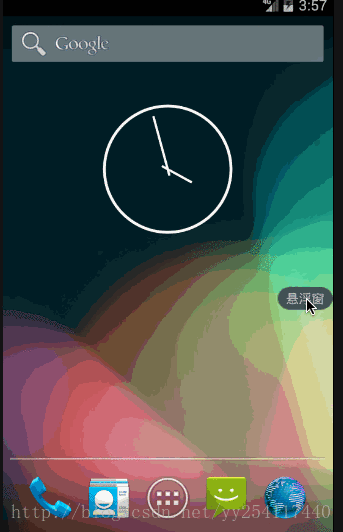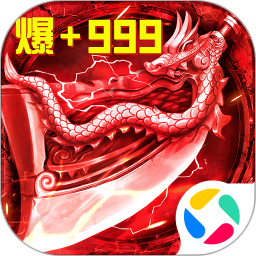Android利用WindowManager生成悬浮按钮及悬浮菜单
本文模仿实现的是360手机卫士基础效果,同时后续会补充一些WindowManager的原理知识。
整体思路
360手机卫士的内存球其实就是一个没有画面的应用程序,整个应用程序的主体是一个Service。我们的程序开始以后,启动一个service,同时关闭activity即可:
| 代码如下 | 复制代码 |
publicclassMainActivityextendsActivity { privatestaticfinalString TAG = MainActivity.class.getSimpleName(); @Override protectedvoidonCreate(Bundle savedInstanceState) { super.onCreate(savedInstanceState); startService(newIntent(this, FloatWindowService.class)); finish(); } } importandroid.os.IBinder; importandroid.util.Log;
importjava.util.Timer; importjava.util.TimerTask;
publicclassFloatWindowServiceextendsService { privatestaticfinalString TAG = FloatWindowService.class.getSimpleName();
publicFloatWindowService() { } @Override publicintonStartCommand(Intent intent,intflags,intstartId) { Log.d(TAG,"on start command"); FloatWindowManager.instance(getApplicationContext()).createFloatWindow(); returnsuper.onStartCommand(intent, flags, startId); }
@Override publicIBinder onBind(Intent intent) { // TODO: Return the communication channel to the service. thrownewUnsupportedOperationException("Not yet implemented"); }
} | |
我们要注意的是,传统的Service默认是运行在UI线程中的,这点与封装了一个Thread和Handler的intentService不同,所以我们可以直接在Service中更改UI相关的内容。
再来看一下FloatWindowManager中的方法:
| 代码如下 | 复制代码 |
publicvoidcreateFloatWindow() { if(isWindowShowing())return; WindowManager windowManager = getWindowManger(context); intscreenWidth = windowManager.getDefaultDisplay().getWidth(); intscreenHeight = windowManager.getDefaultDisplay().getHeight(); if(floatLayout ==null) { floatLayout =newFloatLayout(context); if(smallLayoutParams ==null) { smallLayoutParams =newWindowManager.LayoutParams(); smallLayoutParams.type = WindowManager.LayoutParams.TYPE_PHONE; smallLayoutParams.format = PixelFormat.RGBA_8888; smallLayoutParams.flags = WindowManager.LayoutParams.FLAG_NOT_TOUCH_MODAL | WindowManager.LayoutParams.FLAG_NOT_FOCUSABLE; smallLayoutParams.gravity = Gravity.LEFT | Gravity.TOP; smallLayoutParams.width = FloatLayout.viewWidth; smallLayoutParams.height = FloatLayout.viewHeight; smallLayoutParams.x = screenWidth; smallLayoutParams.y = screenHeight /2; } } windowManager.addView(floatLayout,smallLayoutParams); } | |
以及自定义的View:
| 代码如下 | 复制代码 |
android:id="@+id/small_layout" android:background="@drawable/bg_small" android:orientation="vertical"android:layout_width="60dip" android:layout_height="25dip"> android:layout_width="match_parent" android:gravity="center" android:text="悬浮窗" android:layout_height="match_parent"/> publicclassFloatLayoutextendsLinearLayout { publicstaticintviewWidth; publicstaticintviewHeight; privateWindowManager windowManager; publicFloatLayout(finalContext context) { super(context); windowManager = (WindowManager) context.getSystemService(Context.WINDOW_SERVICE); LayoutInflater.from(context).inflate(R.layout.small_layout,this); View view = findViewById(R.id.small_layout); viewWidth = view.getLayoutParams().width; viewHeight = view.getLayoutParams().height; setOnTouchListener(newOnTouchListener() { @Override publicbooleanonTouch(View v, MotionEvent event) { FloatWindowManager.instance(context).createFloatMenu(); returntrue; } }); } } | |
自定义的View除了加载了一个布局,就是设置了一个Touch监听器,用于点击悬浮窗弹出菜单。注意这里要使用 view.getLayoutParams() 来获取视图的宽和高,因为在构造方法中,这个View并没有被measure完成,所以采用view.getHeight得到的宽高是0。
创建菜单的方法相似,同样通过WindowManager:
| 代码如下 | 复制代码 |
publicvoidcreateFloatMenu() { if(menuLayout !=null)return; Log.d(TAG,"create float menu"); WindowManager windowManager = getWindowManger(context); if(menuLayout ==null){ menuLayout =newMenuLayout(context); menuLayoutParams =newWindowManager.LayoutParams(); menuLayoutParams.type = WindowManager.LayoutParams.TYPE_PHONE; menuLayoutParams.format = PixelFormat.RGBA_8888;
} windowManager.addView(menuLayout,menuLayoutParams);
} | |
自定义的菜单将背景设置成半透明,同时分成上下两部分,上部分点击删除菜单,下部分是一些展示的内容:
| 代码如下 | 复制代码 |
android:orientation="vertical"android:layout_width="match_parent" android:background="#96000000" android:layout_height="match_parent"> android:layout_width="match_parent" android:id="@+id/trans_part" android:orientation="horizontal" android:layout_weight="1" android:layout_height="0dp"> android:layout_width="match_parent" android:layout_weight="1" android:background="@color/colorPrimary" android:layout_height="0dp"> android:layout_width="match_parent" android:text="存放content" android:layout_height="match_parent"/> publicclassMenuLayoutextendsLinearLayout { publicMenuLayout(finalContext context) { super(context); LayoutInflater.from(context).inflate(R.layout.transparent_layout,this); View view = findViewById(R.id.trans_part); view.setOnClickListener(newOnClickListener() { @Override publicvoidonClick(View v) { FloatWindowManager.instance(context).removeMenuLayout(); } }); } } | |
可以看见,实现悬浮窗,其实就是通过windowManager.addView 时,在LayoutParam 的type设置为TYPE_PHONE,这样你的视图就是系统级视图,可以覆盖在全部程序的最上面。其余的,更多的是自定义View的知识。
















